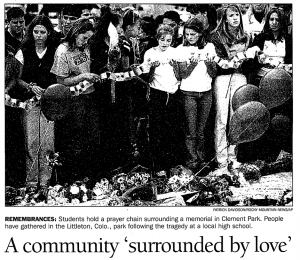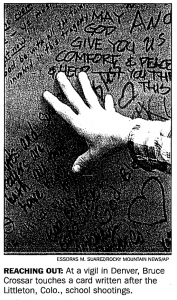A Community ‘Surrounded by love’: With poems and prayers, Denver residents give support after Columbine High shooting:
The article, from The Christian Science Monitor published on April 23, 1999, serves to illustrate the community response following the Columbine High School shooting. It further sheds light on the strength and resilience present within the community. The article begins by highlighting a note someone wrote, reading “‘You have been shattered by their hate. But you are surrounded by our love.”’ This emphasizes the strong sense of community felt by those in Littleton following the disaster. The article states how thousands of Coloradans are gathered on a lawn adjacent to Columbine High School, all sharing “the compelling need to be present here, to help in any way they can”. Further, residents from suburbs on the opposite side of the Denver area came to show their support, showing how the strong sense of community extends beyond Littleton and into neighboring communities.
 The article then displays the resilience of the community through highlighting past tragedies: from when six years prior there were high accounts of gang violence, to the year prior when two were shot in a racially-motivated act against an immigrant. The events were met with strong support from the Denver community, with vigils and prayer services held to honor the lives lost, and marches and peaceful protests held to combat gang violence. This history of Denver’s resilience serves to illustrate how their response to the events of Columbine would be placing an emphasis on love and support, as seen through the note the article began with: the residents are working to create an atmosphere of love that can allow for healing and processing of the events.
The article then displays the resilience of the community through highlighting past tragedies: from when six years prior there were high accounts of gang violence, to the year prior when two were shot in a racially-motivated act against an immigrant. The events were met with strong support from the Denver community, with vigils and prayer services held to honor the lives lost, and marches and peaceful protests held to combat gang violence. This history of Denver’s resilience serves to illustrate how their response to the events of Columbine would be placing an emphasis on love and support, as seen through the note the article began with: the residents are working to create an atmosphere of love that can allow for healing and processing of the events.

Further, the article emphasizes the impact of personal connections within the community response. This is seen through Columbine High School Alumni Sarah Tomicih, whose younger brother was a student at the school at the time of the shooting. Tomicih drove home from her school immediately after hearing the news, and though her brother was safe, she wanted to stay home to be able to help in any way she could. Tomicih emphasized that she wanted to be able to be there and ‘“just listen to anyone who needs to talk about this.”’ This personal connection reflects the strong presence of empathy and solidarity within the community.
Columbine Tragedy Claims Another Victim
The article ‘Columbine Tragedy Claims Another Victim’ from the Washington Post serves to illustrate the lasting effects of Columbine not only on the survivor’s themselves, but additionally the survivor’s family members, shedding light on the impact the events have had on individuals mental health. The article focuses on Carla Hochhalter, the mother of survivor Anne Marie Hochhlater, who was severely injured in the shooting. Carla Hochhalter committed suicide six months following the shooting, and was “declared dead at the same hospital where her daughter was saved by the heroic work of emergency room doctors.”
According to friend Connie Michalik regarding Hochhlater’s suicide, “First you’re devastated, then you’re angry, and then you move on to deal with it. She never really left the devastation stage. She was just stuck there.” This illustrates the indirect impacts of Columbine. As Hochhlater’s daughter Anne Marie was severely injured in the shooting and was paralyzed in both her legs, it took an immense toll on Hochhalter, with her constantly worrying about Anne Marie. Michalik further stated “She was just so worried about Anne Marie. How she was going to get around school, how she was going to be able to go to college, how she would be able to drive. She was just so focused on Anne Marie.”

Hochhlater’s anxiety regarding Anne Marie is representative of the harshly distorted realities many survivors and their families had to face, suggesting how the most difficult aspect of disasters is not the survival of the events, but living and coping with the aftermath of it. Hochhlater’s suicide is just one example of the importance of recognizing and prioritizing mental health awareness and treatment in this disaster. The article does not explicitly mention anything regarding mental health or mental illness, though in an interview done several years later, Anne Marie stated her mother had been struggling with depression prior to Columbine, and that the shooting was not the sole cause of her suicide. The article’s lack of explicit discussion of mental illness serves to illustrate the underlying stigma surrounding mental health, further exhibiting the need for awareness and education surrounding mental health and illness.